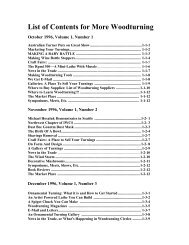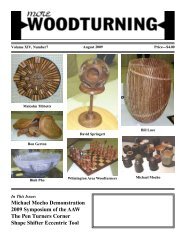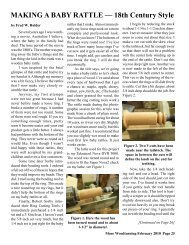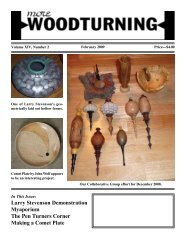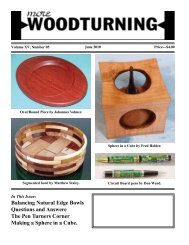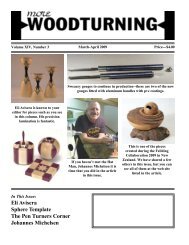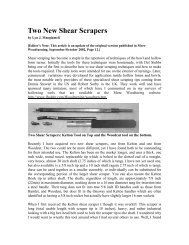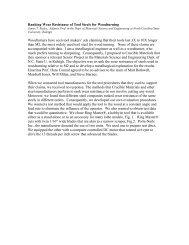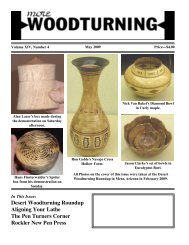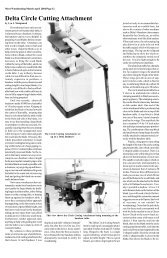Robust Lathe Review - More Woodturning
Robust Lathe Review - More Woodturning
Robust Lathe Review - More Woodturning
You also want an ePaper? Increase the reach of your titles
YUMPU automatically turns print PDFs into web optimized ePapers that Google loves.
the depth to which they can be usedbecause of their overall length. Forfirst hollowing tools, it is a goodidea to select tools that have a flat onthe bottom to help reduce rotationalforces on the tool.If you have internet access, LynJ. Mangiameli wrote an excellentfive part series on hollowing toolsthat were published in <strong>More</strong> <strong>Woodturning</strong>beginning in the July 2004issue and ending in the December2004 issue. These articles can befound at my web site http://www.morewoodturning.net/articles2.php.If you are just getting into doinghollow forms and wishing somedetailed guidance on purchasingtools, this is about the most extensivetreatment of the subject thatI’ve read anywhere.Because hollowing vessels canbe hard on the anatomy, the stabilizedboring bar came into existence.I’m not sure who came up with thisidea, but I first saw it used by LyleJamieson and then later by FrankSudol using the stabilized boring barto hollow vases, etc. In 1999, I wrotea report on a further developmentthat made hollowing vessels eveneasier, the laser pointer was used tomeasure wall thickness during thehollowing. See this report at my website: http://www.morewoodturning.net/articles/laser_pointer.php. Thislatter system with some form ofstabilized boring bar has enabledmany people to make hollow formsthat would never have attempted itwith standard hollowing tools.—Fred HolderLyle’s Response: First, mydefinition of a hollow form is anyturning that I can not reach withbevel supported cuts with a bowlgouge or spindle gouge. If I canreach the surface with a bevel supportedslicing cut I can create a morecontinuous line and sweeter shapesthat slice through the fibers cleanerthan we can with boring bars or hollowingtools. The grain orientationcan be end grain or side grain. It’sthe shape of the vessel that dictateswhat tools we use and weather it isa hollow form or bowl shape.Fred addressed the “what”tools are available. Let me addressthe “how” a bit. I could write a bookabout the subject. And probably Ihave over the years written enoughvolume to compile a book. There isa lot more to hollowing than usingthe right tools. There are multitudesof topics needed to know about howto hollow. There is tool control,chucking methods, working in stages,grain orientation, sharpening,reversing options, design elements,laser measuring techniques, and onand on and on.Let me break it down to onemajor problem...vibration. Vibrationis a no-no, we cant go there.When we get vibration we needto stop and fix it. When we getvibration, nothing good can happen,it will always get worse, andsomething very bad can be the endresult. Vibration can be caused inthree different ways.First, the method of holdingthe wood can fail. Here is where Iwould never use a chuck. The chuckis not what fails, but it is the fact weare grabbing a sponge. The woodcompresses and fails to transfer thepower and stability of the lathe tothe wood. Use a strong faceplatewith many screws for a better gripof the wood, reducing the vibrationtendencies.Second, the wood can flex andvibrate under the stresses of the cuts.Here we learn to work in stages sowe have lots of waste wood at thebottom of the vessel to support thecut way out at the mouth opening.Visualize, we are turning a goblet12 inches tall and three inches indiameter. Can I grip a 3x3x12 pieceof wood in any fashion and hollowout the goblet without vibration??Impossible!! So I need to start witha larger piece of wood and have supportfor the hollowing cuts and workmy way back to the foot gradually.All the time having waste woodsupporting the wood and preventingvibration. Is it OK to waste a littlewood here??. We have to fight ourfrugal gene here, its only firewood.The last resort for me would be touse a steady rest. They are a nightmareto use and get in the way andoften dictate the shape...not a goodplan.The third way vibration happensis extending too far into thevessel with too large of an overhangover the tool rest. In this case theboring bar just plain starts to bendand flex and vibrate. There aremany variables that exacerbate thevibration, tool control, green woodvs. dry wood, porous wood vs.tight grain wood, and how sharpthe tools are. The way to stop theboring bar from vibrating would beto take light, more efficient cuts oruse a larger diameter boring bar.Just because the boring bar is 20inches long does not mean you canturn a 20 inch deep vessel. Whiteknuckling and gritting your teeth toforce your way deeper can get youin big trouble.Its not safe to hollow with vibration.The sound of the cut shouldbe a hissing sound, nothing more.[Continued on Next Page]<strong>More</strong> <strong>Woodturning</strong> February 2010 Page 9



